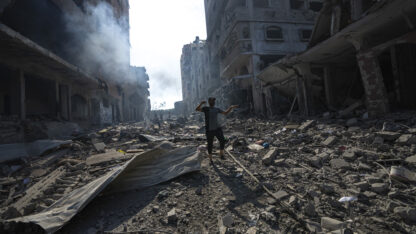Some of the worst violence from this week’s Hamas attacks in Israel took place in small Israeli communities near Gaza called kibbutzim.
Kfar Aza, Be’eri, Nahal Oz, Magen — all of them small, sleepy kibbutzim, the Hebrew plural for kibbutz, whose names have been printed across newspaper headlines and TV chyrons since becoming the sites of atrocities and warfare. Kibbutz residents have been killed and taken hostage at a scale that has shocked those who escaped unscathed.
The kibbutz is a uniquely Israeli phenomenon with a significant cultural legacy and an important role in the nation’s history. Here’s what to know.
What is a kibbutz?
The word itself means “gathering” in Hebrew. Kibbutzim are a communal living situation unique to Israel. There are about 270 kibbutzim dotted across Israel.
At their heart, kibbutzim are small towns — typically with somewhere between 100 and 1,000 residents — historically centered around collective farms. In recent decades, some have come to thrive on modern industry and tourism.
Central to the kibbutz are roots in socialist and Marxist ideas about collective living. Early kibbutzim were exercises in radical democracy, said David Leach, author of the book “Chasing Utopia: The Future of the Kibbutz in a Divided Israel.”
“There was no private property. They had their meals together in many cases. They raised their children communally,” Leach said.
“I would say they are considered one of the most successful experiments in voluntary socialism,” said Ran Abramitzky, a professor of economics at Stanford University. “Jewish immigrants who founded kibbutzim rejected capitalism and wanted to form a more socialist society.”
Kibbutz residents have never made up a majority of Israel’s residents. (Currently, less than 3% of Israel’s population live on one.) Despite their small numbers, kibbutzim have had outsized cultural and political influence on Israel for much of its history, with many politicians, military leaders, intellectuals and artists all coming from kibbutzim. Politics in kibbutzim are associated with the left-wing and peace solutions.
When did they start?
The first kibbutz was established in 1910, and over the decades that followed, dozens were formed across the territory that would become Israel.
Historically, many were formed by young Jews from eastern Europe who believed in the Zionist mission of forming a Jewish homeland in Palestine, which was once part of the Ottoman Empire and later under British control. Others came to escape antisemitism and, later, the Holocaust.
“The kibbutz was for them more like an extended family. They provided safety nets,” said Abramitzky, who also authored the book “The Mystery of the Kibbutz: Egalitarian Principles in a Capitalist World.”
Before the formation of the state of Israel, the kibbutz played an important role in the Zionist mission of state-building. In the 1930s and 1940s, as it became clear that the creation of a Jewish state was likely, some kibbutzim were placed strategically near regions like Gaza in order to help stake the future claim.
“If you look at any map of Israel, you can almost connect the dots around the border regions, and there will be kibbutzim,” said Leach, who is also a professor of writing at the University of Victoria in Canada.
That dual purpose fed the early stereotype of a kibbutz resident, or a kibbutznik, as a combination of farmer and fighter — someone who was there to both “farm the land but also establish its borders and defend it,” Leach said.
What is life like there now?
Most kibbutzim have given up the traditional systems of communal living. Typically, residents with jobs keep their own income, and parents raise their own children.
They are largely considered to be quiet, idyllic places to live, said Abramitzky. Many have aging populations.
“It’s this picturesque village in the countryside, with small apartments surrounded by these lush green walking paths, swimming pool, cultural centers, the dining hall,” he said. “It’s typically — ironically — an incredibly peaceful and safe place.”
While residents are still often left-leaning, kibbutzim are increasingly politically diverse, said Leach of the University of Victoria.
“Even though you have people who are more oriented toward peace and reconciliation, others have their attitudes hardening. And that’s only going to happen more after the recent attacks,” he said.
In kibbutzim located close to the border with Gaza, rockets from Hamas had long been a semiregular part of life.
But now, the small communities within eyeshot of Gaza have been subjected to more violence than residents ever imagined. The streets of tiny Nahal Oz were filled with bodies after Israeli soldiers cleared the area of Hamas fighters, Israeli officials say. The Israeli military is using the farming community Kfar Aza as a staging ground for operations.
And in Be’eri, a kibbutz located a few miles southeast of Gaza with just over 1,000 residents, Israeli authorities say more than 100 people were killed and others kidnapped.
One of the missing residents was Vivian Silver, 74, a woman who had spent her retirement pursuing peace in the region, her son Yonatan Zeigen told NPR.
“She would drive sick Palestinians from Gaza to Israeli hospitals. So apart from being a wonderful mother and grandmother, that was her essence,” Zeigen said.
Copyright 2023 NPR. To see more, visit https://www.npr.org.
9(MDAxODM0MDY4MDEyMTY4NDA3MzI3YjkzMw004))

9(MDAxODM0MDY4MDEyMTY4NDA3MzI3YjkzMw004))









